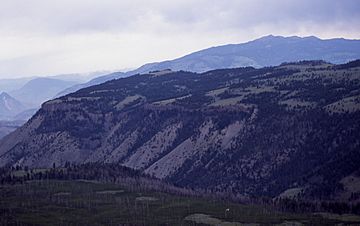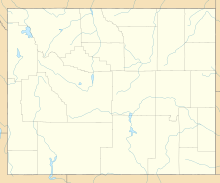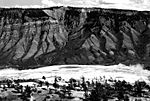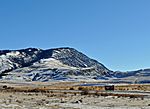Mount Everts facts for kids
Quick facts for kids Mount Everts |
|
|---|---|

Aerial view of Mount Everts
|
|
| Highest point | |
| Elevation | 7,846 ft (2,391 m) NAVD 88 |
| Geography | |
| Parent range | Gallatin Range |
| Topo map | USGS Mammoth |
Mount Everts is a cool mountain peak in Yellowstone National Park, Wyoming. It's about 7,846 feet (2,391 meters) tall! You can find it close to Mammoth Hot Springs. This mountain was named after a brave explorer named Truman C. Everts, who was part of an important expedition back in 1870. Mount Everts is located just south of Gardiner, Montana and east of Mammoth Hot Springs.
Contents
The Story Behind the Name
Mount Everts got its name from Henry D. Washburn. He was the leader of the Washburn Expedition. He named the mountain shortly after Truman C. Everts was found. Truman Everts had gotten lost in Yellowstone for 37 days after the expedition ended!
At first, Washburn named a different mountain after Everts. That mountain is now called Mount Sheridan. But later, Washburn changed his mind. He decided to name the current Mount Everts after Truman Everts. He thought this mountain was very close to where Everts was rescued.
Actually, Everts was rescued a few miles northeast of the mountain. This was near where Blacktail Deer Creek flows into the Yellowstone River. Mount Everts is the main natural feature that separates the town of Gardiner from the Yellowstone River. Mr. Everts himself often said that the much grander Mount Sheridan should have kept his name.
How Mount Everts Was Formed
Most of Mount Everts is made of rocks from the Cretaceous era. This was a long time ago, between 120 and 70 million years ago!
Ancient Seas and Sediments
During the Cretaceous period, a huge shallow sea called the Western Interior Seaway covered much of North America. This sea left behind layers of mud, sand, and other materials. These layers eventually turned into the rocks we see today.
- The first rock layer in the Yellowstone area is called the Telegraph Creek formation. It's about 100 million years old and is mostly made of a soft rock called shale.
- Next came the Eagle formation, about 75 million years ago. This layer is mostly sandstone. It formed in shallower water, like along ancient beaches and river deltas.
- The Everts formation is about 70 million years old. It's also mostly sandstone, but it has layers of coal. These coal layers formed from ancient plants that grew in swampy areas.
Missing Rocks
There are no rocks on Mount Everts from 65 million years ago to 2.1 million years ago. This gap in the rock record is called an unconformity. It means that during this long time, either very few rocks were formed, or any rocks that did form were worn away by wind and water.
Volcanic Activity
About 2.1 million years ago, the Yellowstone hot spot erupted. This huge eruption left a special type of rock called Huckleberry Ridge tuff on the southern part of Mount Everts. It's the youngest rock you'll find on the mountain.
- The tuff was created by several eruptions around 2.1 million years ago.
- First, hot ash fell from the sky. You can still see this as a thin, white rock layer about eight feet thick. This ash was so hot that it actually baked the older sedimentary rocks it landed on! The heat made these rocks turn a darker red color.
- After the ash, fast-moving flows of hot gas and rock pieces, called pyroclastic flows, rushed through the area. These flows moved incredibly fast, sometimes hundreds of miles per hour! They deposited most of the Huckleberry Ridge tuff.
Mountain Rising
Originally, the area where the tuff landed was lower than the surrounding hills. But over the last 2.1 million years, Mount Everts has risen about 1,600 feet (488 meters)! This process is called topographic inversion. It means that areas that were once low become high.
- Most of this uplift happened because of "thermal bulging." This is when hot rock from deep underground pushes the land upwards, connected to the Yellowstone hot spot.
- Also, the tuff rock is harder than the other rocks around it. So, as wind and water wore away the softer surrounding rocks, the harder tuff of Mount Everts stood tall, making the nearby canyons deeper.
Gallery
- Images of Mount Everts
-
Mount Everts' namesake, Truman C. Everts
-
Mount Everts from Gardiner, Montana





